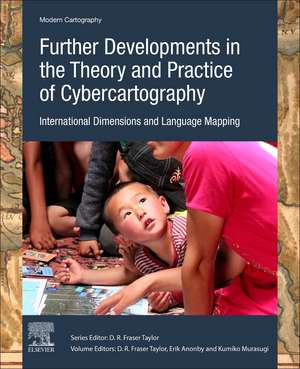Further Developments in the Theory and Practice of Cybercartography: International Dimensions and Language Mapping: Modern Cartography Series, cartea 7
Editat de D.R. Fraser Taylor, Erik Anonby, Kumiko Murasugien Limba Engleză Paperback – 16 sep 2019
This new edition delves deep into Mexico, Brazil, Denmark, Iran and Kyrgyzstan, demonstrating how insights emerge when cybercartography is applied in different cultural contexts. Meanwhile, other chapters contain case studies by a talented group of linguists who are breaking new ground by applying cybercartography to language mapping, a breakthrough that will provide new ways of understanding the distribution and movement of language and culture.
- Highlights the relationship between cybercartography and critical geography
- Incorporates the latest developments in the field of cybercartography, including International Dimensions and Language Mapping
- Showcases the legal, ethical and policy implications of mapping local and traditional knowledge
Preț: 879.06 lei
Preț vechi: 1227.73 lei
-28% Nou
Puncte Express: 1319
Preț estimativ în valută:
168.20€ • 175.62$ • 139.21£
168.20€ • 175.62$ • 139.21£
Carte tipărită la comandă
Livrare economică 28 martie-11 aprilie
Preluare comenzi: 021 569.72.76
Specificații
ISBN-13: 9780444641939
ISBN-10: 0444641939
Pagini: 554
Dimensiuni: 191 x 235 x 38 mm
Greutate: 0.94 kg
Ediția:3
Editura: ELSEVIER SCIENCE
Seria Modern Cartography Series
ISBN-10: 0444641939
Pagini: 554
Dimensiuni: 191 x 235 x 38 mm
Greutate: 0.94 kg
Ediția:3
Editura: ELSEVIER SCIENCE
Seria Modern Cartography Series
Public țintă
University faculty, graduate students, senior undergraduates in cartography, geology, and geography; faculty, graduate students and senior undergraduate students in linguistics; students and faculty in rural community development and Indigenous studies; policy makers in local level development in Mexico, Brazil and Canada; Indigenous communities.Researchers and planners in Indigenous and local development, archivists and museum planners and computer scientists.
The book is not designed as a text book, but would be suitable as supplementary reading in both senior undergraduate level and graduate level courses in cartography, geography and linguistics, as well as in community development and Indigenous studies.
Cuprins
I. The Evolution of Cybercartography
1. Cybercartography Revisited
2. The Theory and Practice of Cybercartography: An Introduction
3. Cybercartography: A Multimodal Approach
4. Some Recent Developments in the Theory and Practice of Cybercartography: Applications in Indigenous Mapping: An Introduction
5. Cybercartography and Volunteered Geographic Information
6. Further Developments in the Theory and Practice of Cybercartography: Exploring Web 2.0 and Participatory Software for Building Geolocated Narratives
7. A Spatial Typology of Cinematic Narratives
8. Considerations for Informed Consent in the Context of Online, Interactive Atlas Creation
9. Cybercartography and Traditional Knowledge: Responding to Legal and Ethical Challenges
10. Cybercartography for Education: The Application of Cybercartography to Teaching and Learning in Nunavut, Canada
11. The Preservation and Archiving of Geospatial Data and Cybercartography as a Proactive Preservation
12. Conclusion and the Future of Cybercartography
13. Developments in the Nunaliit Cybercartographic Data Management Platform
14. Cybercartography and The Critical Cartography Clan
II. International Dimensions and New Applications
15. Storytelling with Cybercartography: The William Commanda Story
16. Cybercartography and the Historical Geography of Roman Britain
17. Digital Return of Inuit Ethnographic Collections using Nunaliit
18. Cybercartography as a Transdisciplinary Approach to Solve Complex Environmental Problems: A Case Study of Kumeyaay Peoples of Baja California, Mexico and the Conservation of Oak Trees
19. The Territories of the Indigenous Peoples of Baja California, Mexico: Semiotic Dimensions in the Study of Landscapes
20. The Potential of Cybercartography in Brazil: A Cybercartographic Atlas for Lencois Maranhenses National Park, Maranhao State, Brazil
21. Cybercartography for Governance: Mapping Traditional Ecological Practices in Naryn Province of Kyrgyzstan
III. New Approaches to Language Mapping
22. Expanding the Boundaries of Language Mapping
23. Representing Complementary User Perspectives in a Language Atlas
24. Cybercartography in Indigenous Language Education
25. Applying the Nunaliit Framework to the Visualization of Complex Linguistic Variation
26. Mapping Kanyen’kéha (Mohawk) Ethnophysiographical Knowledge
Conclusion: The Future of Cybercartography
27. Conclusions: What We Have Learned and What Lies Ahead
1. Cybercartography Revisited
2. The Theory and Practice of Cybercartography: An Introduction
3. Cybercartography: A Multimodal Approach
4. Some Recent Developments in the Theory and Practice of Cybercartography: Applications in Indigenous Mapping: An Introduction
5. Cybercartography and Volunteered Geographic Information
6. Further Developments in the Theory and Practice of Cybercartography: Exploring Web 2.0 and Participatory Software for Building Geolocated Narratives
7. A Spatial Typology of Cinematic Narratives
8. Considerations for Informed Consent in the Context of Online, Interactive Atlas Creation
9. Cybercartography and Traditional Knowledge: Responding to Legal and Ethical Challenges
10. Cybercartography for Education: The Application of Cybercartography to Teaching and Learning in Nunavut, Canada
11. The Preservation and Archiving of Geospatial Data and Cybercartography as a Proactive Preservation
12. Conclusion and the Future of Cybercartography
13. Developments in the Nunaliit Cybercartographic Data Management Platform
14. Cybercartography and The Critical Cartography Clan
II. International Dimensions and New Applications
15. Storytelling with Cybercartography: The William Commanda Story
16. Cybercartography and the Historical Geography of Roman Britain
17. Digital Return of Inuit Ethnographic Collections using Nunaliit
18. Cybercartography as a Transdisciplinary Approach to Solve Complex Environmental Problems: A Case Study of Kumeyaay Peoples of Baja California, Mexico and the Conservation of Oak Trees
19. The Territories of the Indigenous Peoples of Baja California, Mexico: Semiotic Dimensions in the Study of Landscapes
20. The Potential of Cybercartography in Brazil: A Cybercartographic Atlas for Lencois Maranhenses National Park, Maranhao State, Brazil
21. Cybercartography for Governance: Mapping Traditional Ecological Practices in Naryn Province of Kyrgyzstan
III. New Approaches to Language Mapping
22. Expanding the Boundaries of Language Mapping
23. Representing Complementary User Perspectives in a Language Atlas
24. Cybercartography in Indigenous Language Education
25. Applying the Nunaliit Framework to the Visualization of Complex Linguistic Variation
26. Mapping Kanyen’kéha (Mohawk) Ethnophysiographical Knowledge
Conclusion: The Future of Cybercartography
27. Conclusions: What We Have Learned and What Lies Ahead






